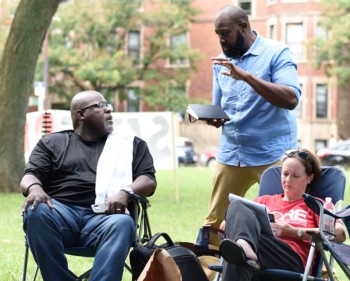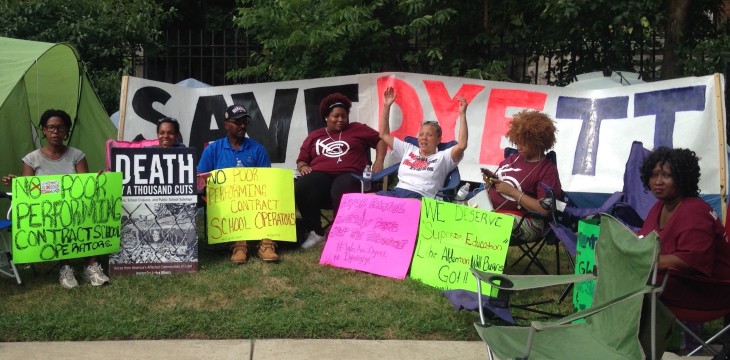By Michelle Gunderson.
Twelve people sit in a circle under the trees outside Dyett High School in Chicago on a hunger strike. They share stories of their experience with Chicago schools – teachers they have loved, principals they have battled, the times they have been arrested fighting for equity in our schools. Those of us who support this courageous act sit to the outside of the circle offering our support through our presence and willingness to listen.
The twelve people have committed to withholding food – parents, grandparents, teachers, a minister, and community members – forming a hunger strike to keep the only open enrollment high school in the Bronzeville community of Chicago.
The demand is simple – the hunger strikers want a public high school designed by the community to re-open at Dyett, not a contract school from a failed supplier or a charter operation. The proposal for the Dyett Global Leadership and Green Technology School comes from extensive outreach in focus groups and town hall meetings with the community. Over a four year period a coalition of community members and education experts built the plan.1 It is a vision for a high school that would build a center of learning and justice for our city’s children.
This is the point where we need to stop and ask ourselves – how far would we be willing to go to ensure we had an open enrollment high school in our own communities? Why would community members be driven to such a drastic action as to risk their health and well-being?
Slow and Intentional Destruction of a School
There has been a long history of ignoring community needs and input in the Bronzeville neighborhood. In 2012 Chicago’s appointed school board voted to “phase out” Dyett High School, but the path of intentional destruction was over a decade in the making.
Rhoda Rae Gutierrez and Pauline Lipman consider Dyett High School a victim of the 3Ds of education reform – destabilization, disinvestment, and disenfranchisement. Dyett experienced destabilizing upheaval in its student population when the Chicago Public Schools decided to “turn around”, convert to charter, or create selective enrollment in the 20 area schools near Dyett. Students were sent from school to school with very little cohesion to community, teachers, or curriculum. There was also considerable disinvestment in Dyett. The school was initially a middle school. When Dyett converted to a high school, no resources were set aside to convert the school – there were no science labs and the school library only had seven books. The Dyett community also experienced disenfranchisement. Decisions about the school were made by a school board appointed by the mayor with no consideration for the outpouring of commitment from the community to keep an open enrollment high school in the neighborhood.
For those of us who have witnessed the privatization of our school systems, we know all too well what is at stake if Dyett High School no longer is in the hands of the community. Once we have one neighborhood without an open enrollment high school it will be all too easy for subsequent parts of our city to fall like dominoes, creating a system of privatized schools.
Getting the Word Out
If you have not heard about the hunger strike until now, it isn’t because you weren’t paying attention. Addressing the circle of hunger strikers, Jitu Brown said, “We are experiencing a local media blackout. Do we all agree that this is true?” Everyone who was fasting in the hunger strike circle nodded in silent agreement. The voice of this community is being silenced and ignored once again.
Many people have asked how they can help. In my mind, the most important work we can do is to keep telling this story. If you are in the Chicago, come to sit with the circle and listen. Then tell more of the story yourself. Use your social media networks to share links and photos while letting the local news sources know that you would like this story told.
this story. If you are in the Chicago, come to sit with the circle and listen. Then tell more of the story yourself. Use your social media networks to share links and photos while letting the local news sources know that you would like this story told.
As a supporter of the hunger strike I sit on the periphery of the circle under the trees of Dyett. I listen to the strikers stories and am in awe of their courage. It is a courage that sustains us and carries us all forward.
“We can’t do any of this if we’re scared,” says Jeanette Taylor-Ramann, one of the mothers participating in the hunger strike.
As difficult as it is, these are times for bold, courageous actions.
______________________________________________________________________________
If you would like to support the hunger strike, please call the board of education at 773 533 1500 and ask to leave a message for current CEO Forrest Claypool. State that you support the Dyett High School Global Leadership and Green Technology School proposal and that a decision should be made now instead of the constant postponement.
1 The coalition includes the following organizations: Annenberg Institute for School Reform at Brown University, Black Metropolis Convention & Tourism Council, Blacks in Green, Chicago Botanic Garden, Chicago Jazz Society, Chicago Teacher’s Union, Du Sable Museum of African American History, Kenwood Oakland Community Organization, Teachers for Social Justice, The Plant, and University of Illinois at Chicago College of Education.
Featured photo by Michelle Gunderson.
Additional photo by Truman Buffett, used with permission.






Leave a Reply